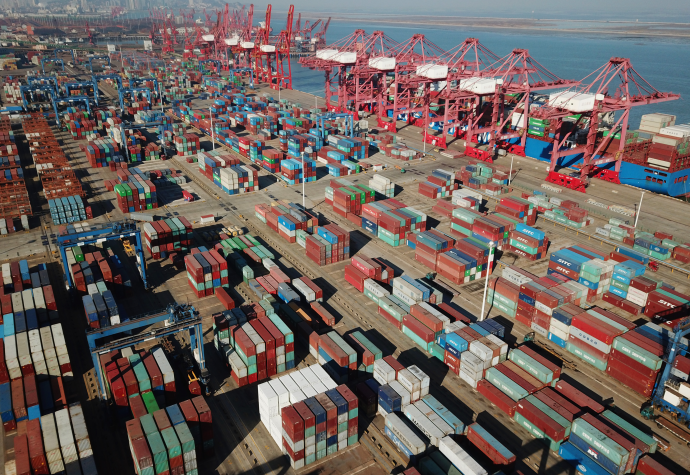
Photo taken on Jan. 12, 2018 shows the container terminal at Lianyungang Port in Lianyungang City, east China's Jiangsu Province.
BEIJING, June 27 (Xinhua) -- China has taken solid steps in promoting its opening-up by lowering import tariffs and easing market access, while new measures on intellectual property protection and a new negative list for market access of foreign investment are in the pipeline.
From July 1, China will cut import tariffs on vehicles and auto parts. For cars, the 25-percent tariff levied on 135 items and the 20-percent duty on four items will both be cut to 15 percent. The items cover passenger cars and certain trucks. Import tariffs on 79 auto parts will all be reduced to 6 percent from the current levels of 8-25 percent, the Ministry of Finance has announced.
The move came after China's exemption of import tariffs on all common drugs including cancer drugs, cancer alkaloid-based drugs, and imported traditional Chinese medicine starting from May 1 this year.
These are only part of a slew of substantial measures China recently announced, as the country promised to significantly broaden market access.
In 2017, China reduced import tariffs on 187 types of consumer goods, including coffee makers, smart toilet seat covers, electric toothbrushes, mineral water and oral cleaning kits. In 2016 and 2015, the country slashed import tariffs on 787 and 749 types of goods, respectively.
China "will actively expand imports, host the first China International Import Expo, and lower import tariffs on automobiles, some everyday consumer goods, and so on. We will open our market wider to promote industry upgrading and more balanced development of trade to provide Chinese consumers with a broader range of choices," said Premier Li Keqiang in the government work report delivered in March.
A timetable for China to further open its financial sector was also disclosed by Chinese leaders during the Boao Forum for Asia annual conference in Hainan Province in April. A number of landmark measures are to be launched this year, according to statements made at the Forum.
On services, financial services in particular, an important announcement was made at the end of last year on measures to raise foreign equity caps in the banking, securities and insurance industries.
China will ensure that these measures are materialized and at the same time make more moves toward further opening up, including accelerating the opening-up of the insurance industry, easing restrictions on the establishment of foreign financial institutions in China and expanding their business scope, and opening up more areas of cooperation between Chinese and foreign financial markets.
Wang Zhigang, a researcher with the Chinese Academy of Fiscal Sciences, believed that "easing restrictions on the establishment of foreign financial institutions in China and expanding their business scope" could bring about a "catfish effect," which will push forward the reform and innovation of the financial sector.
Furthering the open-up of the country's financial sector will accelerate the reshuffling of the industry, help optimize the structure and improve the efficiency, turn high savings into effective investment and promote the quality of financial services, according to Wang.
During the opening-up process, China needs to strike a balance between innovations and risks and strengthen supervision, Wang warned, noting that domestic financial institutions should speed up internal reform to improve their abilities to defuse risks.
China has also pledged to enhance intellectual property protection, a voluntary step taken in accordance with its commitment to the World Trade Organization (WTO) and aimed at improving the market economy, said Yang Changyong, a senior researcher from the Chinese Academy of Macroeconomic Research.




 A single purchase
A single purchase









